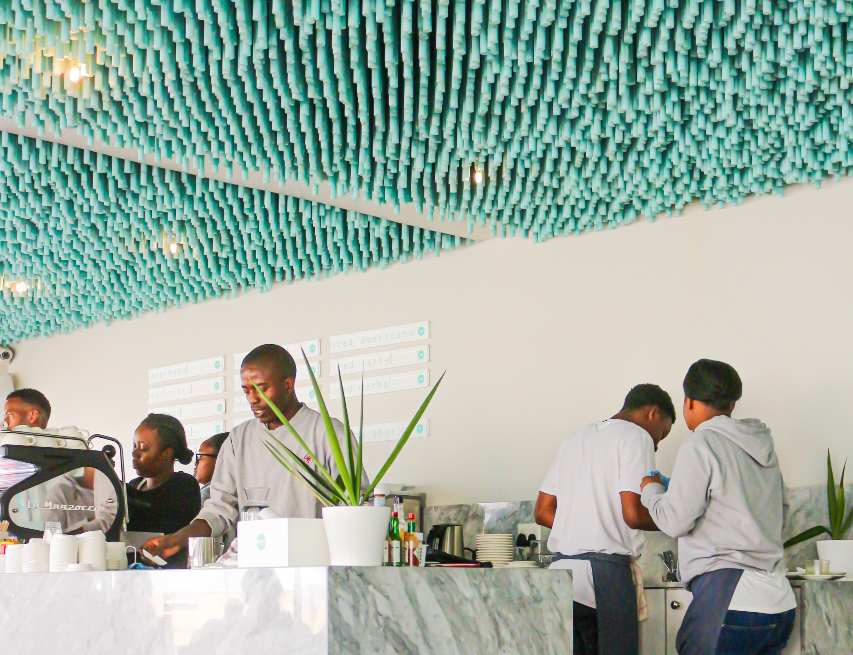Restaurant Redesign and Tech Adoption Motivated by Rise in Takeout Ordering
4 Min Read By Zayn King-Dollie
Over the past few years, the restaurant industry has experienced numerous challenges with the spread of COVID-19 temporarily halting regular operations. While lifted restrictions indicated a hopeful upswing, growing inflation, increasing worker pay and fear of a looming recession have caused the landscape to once again become worrying. These setbacks and evolving customer expectations amid the pandemic have shifted the way that operators are managing their own spaces, as they work toward maximizing efficiency and revenue while reducing operational costs.
Industry sales indicate record-breaking numbers and projections show an increase of 12.4 percent — accounting for over $898B – but that has more to do with price increases and restaurants attempting to recoup the budget spent on ingredients than a true increase in sales. There has also been a rise of digital adoption by consumers since the pandemic. While the acceleration was in large part due to the 2020 shutdowns, the result is a more digitally astute customer. People have changed the way they interact with restaurants, whether that be dining-in or ordering out, using a website or a mobile application.
What has become clear is that potential customers want to leverage different channels when it comes to their dining experience – and restaurants that fail to provide those options are losing a considerable sector of the market and leaving money on the table.
Beyond tech adoption, many are seeing takeout take off — it’s expected to be growing 300 percent faster than dine-in – and restaurants are redesigning their spaces to accommodate takeout orders in an efficient and rapid manner. Restaurants that are accounting for market shifts and pivoting operations to optimize customer experience by integrating technology and making the best use of space are positioning themselves to not only stand out against competitors, but are likely to simultaneously increase revenue.
Understanding the Relationship Between Customer Experience and Expectation
The pinnacle of the dining experience traditionally meant that a customer was planning on eating at a restaurant where they would be serviced by staff. Over time, that has changed. Convenience has trumped almost everything else, and customers expect rapid service and access anywhere. This also means that customers prefer dining at home instead of sitting at a restaurant.
An Oracle survey showing the outcomes of off-premise demand revealed a decline in tolerance when it comes to wait time. The survey showed about a 20% increase in patience when it came to counter order and drive through, compared to 33 percent of customers who said that they would get annoyed after 5 minutes of not being served during a table service order. For businesses that are facing ongoing labor shortages, long wait times have become a more common occurrence. In that same survey, 35% of diners said they are influenced by online reviews when choosing a restaurant. While servicing customers and creating excellent customers is paramount, not all restaurants have the staff to meet consumers' needs – but they can lean on technology to provide support during any gaps in coverage.
Tech Adoption Can Streamline and Support Operations – Delivering Unique Experiences
Whether large or small, new or long-standing, any type of restaurant can find benefits in incorporating technology into their operations. While needs might vary, the value is clear. Online menus that customers can access either on the restaurant’s website or through a QR code scanned via mobile phone are crucial ways to help keep service running smoothly during staffing shortages. Customers are also able to order drinks through these links and dramatically reduce wait times for their orders by being proactive. This allows bar staff, cooks and waiters to start working on orders, and deliver them to customers' tables instead of checking in on the table constantly.
When it comes to accelerating operations, technology streamlines manual processes that create bottlenecks. For many long-standing operators who have resisted tech, ordering is a very analog process. This means customers are either calling or coming in to order. These processes can cause staff to be pulled away from in-person clientele, and can create longer than normal waiting times in the dining room. Restaurants that are adopting and integrating web and mobile applications are able to streamline their ordering process and free up staff from unnecessary tasks, allowing them to provide a stellar dining experience to their in-house customers. From websites to mobile applications, providing different channels for customers to order meets them where they are.
When placing an online order, a patron is more likely to use a restaurant's website than a third-party site, so investing in these digital resources is important. This is great news for restaurants that dislike paying 30 percent of their revenue to third-party providers and delivery services. At a time where restaurants are having to hike prices due to inflation and overall profits aren’t high, losing 30 percent of their revenue can be one challenge too many. Developing a mobile native app allows customers to interact directly with your restaurant, creating a more personalized relationship that people prefer. This allows business owners to implement rewards and loyalty systems, as well as partner with delivery service providers that charge flat fees rather than percentages of revenue.
Redesigning Spaces to Account for Fast-Paced Ordering In-Person and Online
The rise of takeout has provided different avenues for businesses to expand their foothold and increase their gross profits and revenue. Taking into consideration the changing landscape that has customers searching for the fastest and best dining options, restaurants are left pondering how to best approach these changes in an effective manner. One of these ways has been to account for takeout within their own operations and creating a more specific space that directly caters to these types of customers.
Restaurants need to tap into these groups of people without alienating their dine-in customers and maintaining the quality of service and attention. This can be difficult when there are two types of customers looking for two different experiences and only a limited amount of service staff. Some restaurants have not only leveraged technology to streamline ordering, but have also gone forward with redesigning their spaces to create more specified areas for takeout. Creating ordering windows that are accessible from outside of their restaurant is one popular method. This allows online customers to quickly pick up their orders without even coming inside to potentially disrupt the customer experience indoors. As expectations continue to adapt and change, making these types of adjustments to physical spaces can create an optimal atmosphere for all patrons.
While challenging times have many struggling to survive, those who are directly investing into operational improvements will future-proof their business while capturing a larger market share. The short-term outlook is filled with challenges that owners will have to face, but they can be overcome if they leverage strategic implementations of technology. Assessing market changes, customer behavior, tech advancement, and event redesigning floor plans can support operators and outpace competitors. As we look ahead, market concerns may loom – but what restaurants do today could mean the difference between staying in business and being a casualty to the state of the industry.


